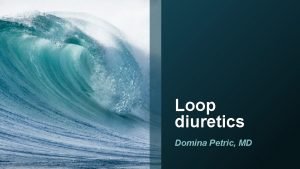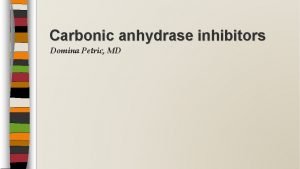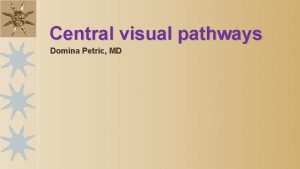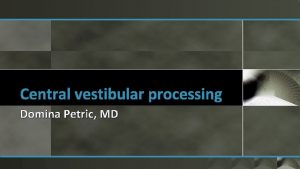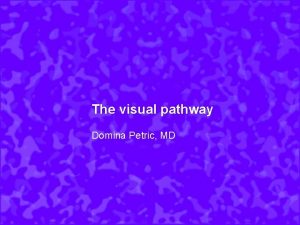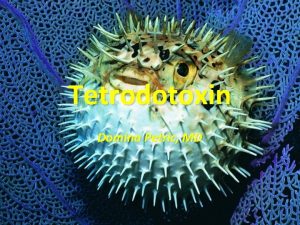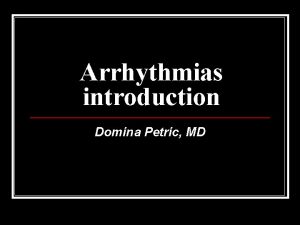Central visual processing Domina Petric MD Introduction The


















- Slides: 18

Central visual processing Domina Petric, MD

Introduction • The ganglion cell axons from the nasal retina go via the medial part of the optic nerve and cross the midline to project in contralateral targets in diencephalon and midbrain. • The ganglion cell axons from the temporal retina go via the lateral part of the optic nerve and remain on the ipsilateral side of the brain. • Lateral geniculate nucleus is a target where ganglion cell axons synapse and from there rise the optic radiations. • Optic radiations go around the lateral ventricle to supply upper and lower parts of the calcarine sulcus where is the primary visual cortex.

The ganglion cell axons from the temporal retina stay ipsilateral. The ganglion cell axons from the nasal retina cross the midline in optic chiasm. From the other eye. . . Optic chiasm Synapse in ipsilateral geniculate nucleus. Synapse in contralateral geniculate nucleus.

Optic radiations Lateral geniculate nucleus http: //www. visembryo. com

Primary visual cortex (V 1) Stria of Gennari: area 17 or the striate cortex. Orientation selectivity of receptive field in V 1 is preferred response to a bar of a particular orientation. Direction selectivity of receptive field in V 1 is preferred response to a bar of a particular direction of motion.

Stria Gennari http: //www. smbs. buffalo. edu

Receptive fields in retina and thalamus Receptive fields in visual cortex And so on. . .

Ocular dominance in V 1 cortex • Two inner layers in the lateral geniculate nucleus: layer one recieves inputs from the contralateral eye and layer two from the ipsilateral eye. • Four outer layers in the lateral geniculate nucleus: layers 4 and 6 are recieving inputs from the contralateral eye and layers 3 and 5 from the ipsilateral eye. • Ocular dominance layers: information from both eyes is mixed first time in the V 1 (striate) cortex.

Lateral geniculate nucleus Contralateral eye inputs Ipsilateral eye inputs Inner layer 1 Inner layer 2 Outer layers 4 and 6 Inner layers 3 and 5

Stereopsis Fixation point is going to be projected on the non corresponding areas of the retinas. That is the mechanism of depth perception: near and far disparities that project to the visual cortex.

Parallel pathways Types of retinal ganglion cells: • P ganglion cell (the smallest) • M ganglion cell (the largest) • K ganglion cell (medium size)

Parallel pathways Axonal projections from small P ganglion cells terminate among small cell layers in the lateral geniculate nucleus: the parvocellular layers (layers 3 to 6 ). Axonal projections from large M ganglion cells terminate in the first two layers of lateral geniculate nucleus (magnocellular layers). Axonal projections from K ganglion cells terminate in a zone between the layers: koniocellular layers.

Parallel pathways Axons from parvocellular layers synapse into the bottom part of layer 4 in the visual cortex (4 Cβ). Axons from magnocellular layers synapse into the layer 4 C�. Axons from koniocellular layers synapse into the layer 3, in the zones rich with oxidative metabolism. Parvocellular layers are concerned with shape and color, magnocellular layers with broad patterns of motion.

Parvocellular layers project to layer C 4β of the visual cortex and those cells and axons are concerned with shape and color of objects. Layer 6 Layer 5 Layer 4 Layer 3 Magnocellular layers project to layer C 4� of the visual cortex and those cells and axons are concerned with motion of objects. Layer 2 Layer 1 Koniocellular layers synapse in the zones rich with oxidative metabolism in the layer 3 of the visual cortex. Their function is unknown.

Extrastriate visual cortex • Those are rings of higher order visual areas. • MT plus region is rich of motion sensitive cells (spatial analysis) and it is part of dorsal processing stream. • Dorsal processing stream is concerned with spatial analysis and answers the question WHERE am I looking at? • Dorsal processing stream goes towards the parietal lobe. • Ventral processing stream adresses the question WHAT or WHO am I looking at? • Ventral processing stream goes towards the temporal lobe.

http: //sciencewise. anu. edu. au Magnocellular pathway is the dorsal processing stream or WHERE pathway. Parvocellular pathway is the ventral processing stream or WHAT (WHO) pathway.

Prosopagnosia Region of posterior occipitotemporal gyrus is called the fusiform gyrus. Damage of the fusiform gyrus causes the inability to recognise faces and that is called PROSOPAGNOSIA.

Literature • https: //www. coursera. org/learn/medic al-neuroscience/lecture: Leonard E. White, Ph. D, Duke University • http: //www. visembryo. com • http: //www. smbs. buffalo. edu • http: //sciencewise. anu. edu. au
 Domina petric
Domina petric Domina petric
Domina petric Rexocef 100 mg
Rexocef 100 mg Domina petric
Domina petric Domina petric
Domina petric Pseudomonopolar
Pseudomonopolar Domina petric
Domina petric Jure petric
Jure petric Dobriša cesarić pjesme lektira za 7 razred
Dobriša cesarić pjesme lektira za 7 razred Atitudes vencedoras
Atitudes vencedoras Domina los aprendizajes requeridos
Domina los aprendizajes requeridos Cada miembro domina una parcela determinada del proyecto
Cada miembro domina una parcela determinada del proyecto Carbonic anhydrase use
Carbonic anhydrase use Kitzler witze
Kitzler witze Domina epistulam
Domina epistulam Top.down processing
Top.down processing Gloria suarez
Gloria suarez Top-down processing vs bottom-up processing
Top-down processing vs bottom-up processing Neighborhood averaging in image processing
Neighborhood averaging in image processing



